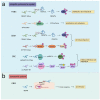A Whole New Comprehension about ncRNA-Encoded Peptides/Proteins in Cancers
- PMID: 36358616
- PMCID: PMC9654040
- DOI: 10.3390/cancers14215196
A Whole New Comprehension about ncRNA-Encoded Peptides/Proteins in Cancers
Abstract
It is generally considered that non-coding RNAs do not encode proteins; however, more recently, studies have shown that lncRNAs and circRNAs have ORFs which are regions that code for peptides/protein. On account of the lack of 5'cap structure, translation of circRNAs is driven by IRESs, m6A modification or through rolling amplification. An increasing body of evidence have revealed different functions and mechanisms of ncRNA-encoded peptides/proteins in cancers, including regulation of signal transduction (Wnt/β-catenin signaling, AKT-related signaling, MAPK signaling and other signaling), cellular metabolism (Glucose metabolism and Lipid metabolism), protein stability, transcriptional regulation, posttranscriptional regulation (regulation of RNA stability, mRNA splicing and translation initiation). In addition, we conclude the existing detection technologies and the potential of clinical applications in cancer therapy.
Keywords: cancers; clinical applications; peptides/proteins encoded by ncRNAs; translation mechanism.
Conflict of interest statement
The authors declare no conflict of interest.
Figures





Similar articles
-
The interplay between m6A modification and non-coding RNA in cancer stemness modulation: mechanisms, signaling pathways, and clinical implications.Int J Biol Sci. 2021 Jun 26;17(11):2718-2736. doi: 10.7150/ijbs.60641. eCollection 2021. Int J Biol Sci. 2021. PMID: 34345203 Free PMC article. Review.
-
Beyond traditional translation: ncRNA derived peptides as modulators of tumor behaviors.J Biomed Sci. 2024 Jun 14;31(1):63. doi: 10.1186/s12929-024-01047-0. J Biomed Sci. 2024. PMID: 38877495 Free PMC article. Review.
-
Translatable circRNAs and lncRNAs: Driving mechanisms and functions of their translation products.Cancer Lett. 2020 Jul 28;483:59-65. doi: 10.1016/j.canlet.2020.04.006. Epub 2020 Apr 28. Cancer Lett. 2020. PMID: 32360179 Review.
-
Translation of noncoding RNAs: Focus on lncRNAs, pri-miRNAs, and circRNAs.Exp Cell Res. 2017 Dec 1;361(1):1-8. doi: 10.1016/j.yexcr.2017.10.010. Epub 2017 Oct 12. Exp Cell Res. 2017. PMID: 29031633 Review.
-
Translation of noncoding RNAs and cancer.Cancer Lett. 2021 Jan 28;497:89-99. doi: 10.1016/j.canlet.2020.10.002. Epub 2020 Oct 7. Cancer Lett. 2021. PMID: 33038492 Review.
Cited by
-
Superenhancer-driven circRNA Myst4 involves in pulmonary artery smooth muscle cell ferroptosis in pulmonary hypertension.iScience. 2024 Sep 12;27(10):110900. doi: 10.1016/j.isci.2024.110900. eCollection 2024 Oct 18. iScience. 2024. PMID: 39351203 Free PMC article.
-
LncRNA-encoded peptides in cancer.J Hematol Oncol. 2024 Aug 12;17(1):66. doi: 10.1186/s13045-024-01591-0. J Hematol Oncol. 2024. PMID: 39135098 Free PMC article. Review.
References
Publication types
Grants and funding
LinkOut - more resources
Full Text Sources
Miscellaneous

